Cattle Pastures
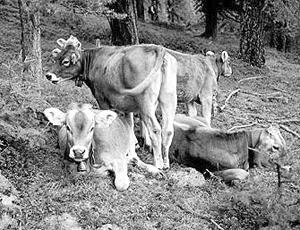 Until the introduction of keeping the cattle in the stables in the second half of the 18th century, the feeding of the cattle, horses, sheep and goats happened by leading them for pasturing in the forest, as the vegetation there constituted the basis of all cattle nutrition. This had of course harmful consequences for the forest. In fact the animals’ hooves packed down the ground all by damaging the leaf and the young buds. That is why up from the beginning of the 13th century, some forest zones had refused access for grazing in order to protect the woodland. As for the Grünewald you can find edicts, regulating the agricultural usage in the woods, dated 14 September 1617, edited by the Archduke Albert and the archduchess Isabelle, or 15 September 1724 by Charles VI. It is only in the second part of the 18th century that the forest was forbidden for all kind of grazing, as the modernisation of agricultural means took forth with the cultivation of potatoes and root crop used then for feeding.
Until the introduction of keeping the cattle in the stables in the second half of the 18th century, the feeding of the cattle, horses, sheep and goats happened by leading them for pasturing in the forest, as the vegetation there constituted the basis of all cattle nutrition. This had of course harmful consequences for the forest. In fact the animals’ hooves packed down the ground all by damaging the leaf and the young buds. That is why up from the beginning of the 13th century, some forest zones had refused access for grazing in order to protect the woodland. As for the Grünewald you can find edicts, regulating the agricultural usage in the woods, dated 14 September 1617, edited by the Archduke Albert and the archduchess Isabelle, or 15 September 1724 by Charles VI. It is only in the second part of the 18th century that the forest was forbidden for all kind of grazing, as the modernisation of agricultural means took forth with the cultivation of potatoes and root crop used then for feeding.
Mulching usage
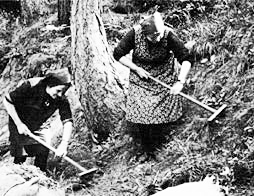 At the end of the middle Ages mulch usage in the woods had become a very important form of agricultural exploitation. That is why the Anwen Farm did not only own the right to fatten the cattle with acorns and pastures and the use of firewood, but also the right to use the forest mulch.
At the end of the middle Ages mulch usage in the woods had become a very important form of agricultural exploitation. That is why the Anwen Farm did not only own the right to fatten the cattle with acorns and pastures and the use of firewood, but also the right to use the forest mulch.
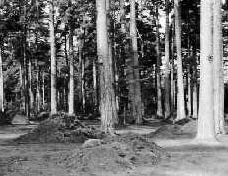 Leaf, pins and plants on the ground were collected by special rakes and could be used in the stables for litter. As a consequence the tree population diminished considerably and important nutrients of the soil were subducted. Later on a reforestation could only be done by planting conifers, as they need few nutrients and grow quickly.
Leaf, pins and plants on the ground were collected by special rakes and could be used in the stables for litter. As a consequence the tree population diminished considerably and important nutrients of the soil were subducted. Later on a reforestation could only be done by planting conifers, as they need few nutrients and grow quickly.
Pig fattening
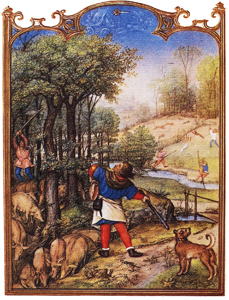 Until the introduction of forage plants for animals in the 18th and 19th century, the domestic pigs were fattened by leading them into the old and light oak and beech groves. Since the Middle Ages there were special regulations defining the number of animals, the beginning and end of pasturing and the felling of fruit trees. In the Grünewald for example there was a special regulation, forbidding pig grazing for the period before the young trees had not yet reached the 8th leaf.
Until the introduction of forage plants for animals in the 18th and 19th century, the domestic pigs were fattened by leading them into the old and light oak and beech groves. Since the Middle Ages there were special regulations defining the number of animals, the beginning and end of pasturing and the felling of fruit trees. In the Grünewald for example there was a special regulation, forbidding pig grazing for the period before the young trees had not yet reached the 8th leaf.
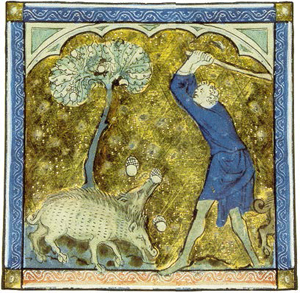 For a long time woods were estimated according to the number of pigs, allowed to circulate and not as today according to the potential timber mass. Up to the modern times, the highest cash income of a forest came from pig fattening rather than timber production. The Grünewald and the related pig fattening was the only source of income for the sovereign at these times before the construction of the first metallurgical site in Dommeldange in 1609.
For a long time woods were estimated according to the number of pigs, allowed to circulate and not as today according to the potential timber mass. Up to the modern times, the highest cash income of a forest came from pig fattening rather than timber production. The Grünewald and the related pig fattening was the only source of income for the sovereign at these times before the construction of the first metallurgical site in Dommeldange in 1609.
Leaf as food for the cattle
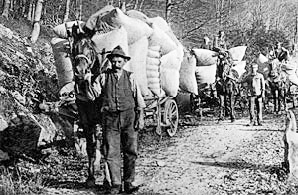 From prehistoric times up to the 20th century, the leaf was collected during winter times to use it as additional food for the animals. For this purpose, the elm, ash, hornbeam and willow leaf was preferred.
From prehistoric times up to the 20th century, the leaf was collected during winter times to use it as additional food for the animals. For this purpose, the elm, ash, hornbeam and willow leaf was preferred.
In the Grünewald pig fattening was regulated as follows:
“The lords of Heisdorff, Walferdange, Ober- and Niederanven have the right to drive their pigs to the pasture of St.Rémy in St.Gertrude. The inhabitants of Bofferdange and Klingerscheuer only may drive their pigs up to the border of the locations called Staffelstein and Schetzelbach. The inhabitants of Sandweiler have the right to lead their pigs to all the the Grünewald pastures, but only by paying 8 Groschen and 7 Soll per year. The inhabitants of Itzig have the right to drive their pigs even at night and that from St. Dyonis up to St.Thomas all by paying a fee of 7 Soll.. The right for pasturing is only given to the inhabitants of Anwen (Ober- and Niederanven).”
